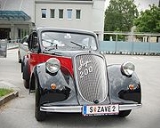
Steyr 100
Encyclopedia
The Steyr 100 and 200 were a series of medium-sized cars built by the Austrian
firm Steyr-Puch from 1934 to 1940.
The cars had a 4-cylinder engine
driving the rear wheels and the streamlined
body, designed by Karl Jenschke, was manufactured by Gläser in Dresden
.
In 1936 the vehicle underwent improvements, creating the Steyr 200, which was produced until 1940. One technical novelty for the 200 model was the starter motor, which also doubled as an alternator
.
Austria
Austria , officially the Republic of Austria , is a landlocked country of roughly 8.4 million people in Central Europe. It is bordered by the Czech Republic and Germany to the north, Slovakia and Hungary to the east, Slovenia and Italy to the south, and Switzerland and Liechtenstein to the...
firm Steyr-Puch from 1934 to 1940.
The cars had a 4-cylinder engine
Engine
An engine or motor is a machine designed to convert energy into useful mechanical motion. Heat engines, including internal combustion engines and external combustion engines burn a fuel to create heat which is then used to create motion...
driving the rear wheels and the streamlined
Streamliner
A streamliner is a vehicle incorporating streamlining in a shape providing reduced air resistance. The term is applied to high-speed railway trainsets of the 1930s to 1950s, and to their successor "bullet trains". Less commonly, the term is applied to fully faired recumbent bicycles...
body, designed by Karl Jenschke, was manufactured by Gläser in Dresden
Dresden
Dresden is the capital city of the Free State of Saxony in Germany. It is situated in a valley on the River Elbe, near the Czech border. The Dresden conurbation is part of the Saxon Triangle metropolitan area....
.
In 1936 the vehicle underwent improvements, creating the Steyr 200, which was produced until 1940. One technical novelty for the 200 model was the starter motor, which also doubled as an alternator
Alternator
An alternator is an electromechanical device that converts mechanical energy to electrical energy in the form of alternating current.Most alternators use a rotating magnetic field but linear alternators are occasionally used...
.

